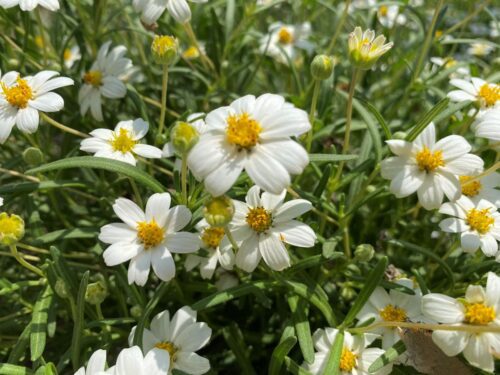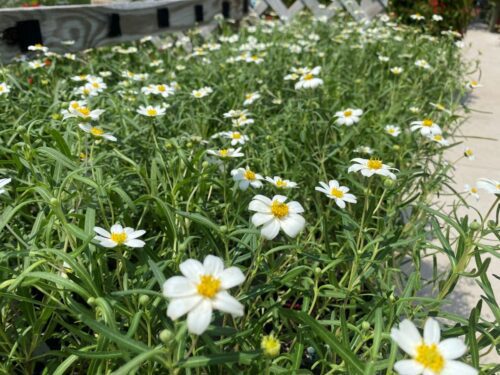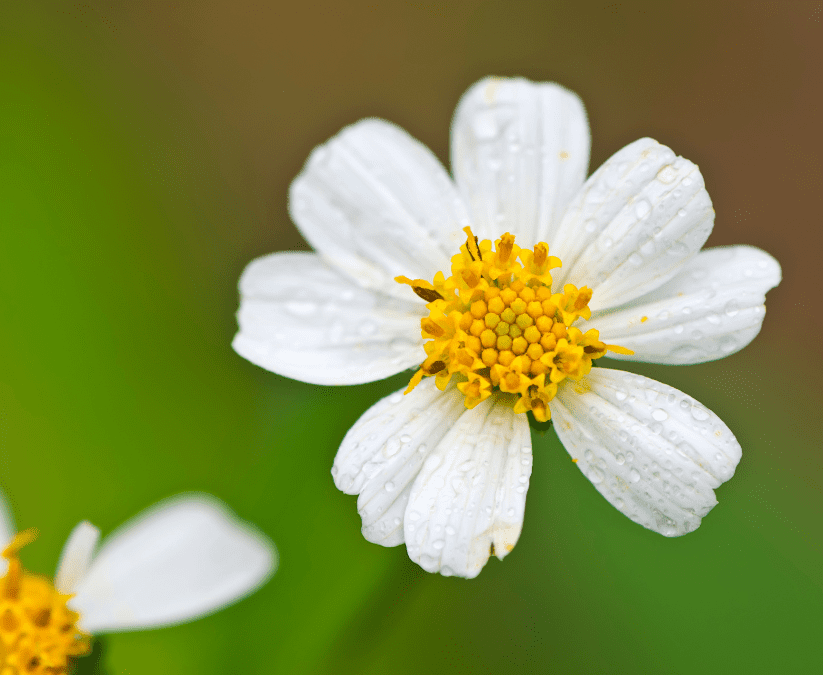The Blackfoot Daisy, scientifically known as Melampodium leucanthum, is a charming perennial that thrives in the Texas landscape. This native plant is celebrated for its delicate beauty and resilience, making it an excellent choice for gardeners in San Antonio and beyond.
Blackfoot Daisy is a low-growing, mounding plant that reaches about 12 inches in height and spreads up to 18 inches. It features small, lance-shaped leaves and produces an abundance of daisy-like flowers. The blooms are white with a yellow center, creating a striking contrast against the plant’s green foliage. These flowers typically appear from spring to fall, providing a long-lasting display of color.
Planting and Care for Blackfoot Daisy
Planting:
- Location: Choose a sunny spot in your garden, as Blackfoot Daisy thrives in full sun.
- Soil: This plant prefers well-drained soil and can tolerate poor, rocky soils, making it ideal for the often challenging Texas terrain.
- Planting Time: The best time to plant Blackfoot Daisy is in the spring or fall when temperatures are milder.
Care:
- Watering: Once established, Blackfoot Daisy is drought-tolerant and requires minimal watering. Water deeply but infrequently, allowing the soil to dry out between watering sessions.
- Fertilization: This plant is not fussy about nutrients and typically does well without additional fertilization. However, a light application of a balanced fertilizer in the spring can promote vigorous growth.
- Pruning: Deadheading spent flowers encourages continuous blooming. Prune lightly if the plant becomes leggy to maintain its compact shape.

Landscaping Uses for Blackfoot Daisy
Blackfoot Daisy is versatile and can be used in various ways to enhance your garden:
- Borders and Edging: Its low growth habit makes it perfect for edging garden beds or creating borders along pathways.
- Rock Gardens: Its preference for well-drained soil and ability to thrive in rocky conditions make it an ideal candidate for rock gardens.
- Containers: Blackfoot Daisy can also be grown in containers, adding a splash of color to patios and balconies.

Blackfoot Daisy Benefits for San Antonio Gardeners
San Antonio’s hot, dry climate can be challenging for many plants, but Blackfoot Daisy is well-suited to these conditions. Here’s why it’s a great choice:
- Drought Tolerance: Its ability to withstand dry spells makes it a low-maintenance option for water-conscious gardeners.
- Heat Resilience: Blackfoot Daisy thrives in the heat, blooming even during the hottest months.
- Pollinator Attractor: The flowers attract pollinators such as bees and butterflies, contributing to the health of your garden ecosystem.
- Native Adaptability: Being a native Texas plant, it is well-adapted to the local environment, reducing the need for extensive care and resources.
- Pest, Disease, and Deer Resistance: This plant is relatively free of pest and disease issues and is rated high on the deer resistance list.
Blackfoot Daisy is a delightful and practical addition to any San Antonio garden. Its beautiful blooms, easy care requirements, and adaptability to the local climate make it a standout choice for both novice and experienced gardeners. Embrace this native treasure and enjoy the benefits it brings to your landscape. These beauties are blooming right now at Rainbow Gardens. Take a look at online order/store pick up availability for Blackfoot Daisy.
~The Happy Gardener, Lisa Mulroy


Does the Blackfoot Daisy have any herbal, medicinal or edible uses?
Hi Deborah,
More extensive research is still needed, but according to multiple sources, it looks like they have found some compounds in Blackfoot daisy with anti-cancer properties. I’m attaching an article stating this and maybe it will give you more info on where to research more.